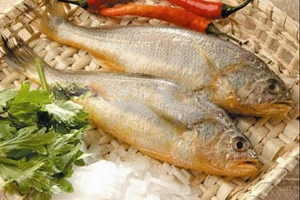 or fish to replace diminished local stocks of favorites like yellow croaker is proving a boon for Argentina, which is already enjoying record sales of red shrimp in China.
or fish to replace diminished local stocks of favorites like yellow croaker is proving a boon for Argentina, which is already enjoying record sales of red shrimp in China.“We are looking to put a lot of containers into China,” said Stuart Anderson, head of export sales at the Santa Maria Group.
Chinese buyers are eager to get hold of Argentinean croakers as well as similar fish like weakfish and black drum, Anderson told SeafoodSource. Logistics helps: China is proving a more lucrative market than Santa Maria’s key West African markets like Nigeria and Cameroon for the firm’s low-end fish like croaker and weakfish — in part because of the more prevalent shipping services connecting China and Latin America. Thus ships delivering Chinese consumer goods to Argentina are going back full with food goods like fish and shrimp.
Demand for both hake and shrimp has been strong in China, according to supplier Sebastian Guridi, head of foreign trade at Moscuzza, a Mar Del Plata based firm which ships squid as well as shrimp and fish to China.
“In the past four years everyone is looking for Argentinian red shrimp,” he said. The firm’s sales in China rose from 400 tons in 2011 to 800 tons in 2012, and he expects that figure to double in 2013.
Guridi explained Chinese buyers are keen on Argentinian shrimp as a wild product, as opposed to Ecuador’s farmed shrimp. A challenge however is finding sufficient large-sized shrimp to supply the Chinese demand for large shrimp for the lucrative gift-box market here. “We are trying to convince them to consider other sizes,” he added.
To boost seafood shipments, trade officials in Buenos Aires have come up with a new “Mar Argentino” brand that will be pushed by all departments involved in seafood promotion, including the agricultural ministry and ProArgex. Maria Florencia Pombo, exports training leader at ProArgex, a state agency tasked with promoting Argentina’s exports, told SeafoodSource the Mar Argentino brand will be promoted in China. A brochure distributed to Chinese buyers describes how the “Argentine Sea, southernmost and wild, is the answer to the increasing international demand for high quality seafood products.” The brochure stresses Argentina’s long and unpopulated coastline and pinpoints the availability of wild Patagonian shrimp as well as hake.
Other Argentine firms tapping China for sales include Empesur, the Argentinean wing of the Mariscos Rodriguez SA group. Boats and a factory in Puerto Deseado have been focused on supplying the Spanish market but having secured Chinese licenses the firm is keen to build sales of Argentinean red shrimp in China, according to sales representative Francisco Pastoriza Martin. “We’re looking for distributors, partners in China,” he told SeafoodSource. The firm has found solid demand for L2 sized shrimp in China and is seeking buyers for its larger brilliante prawn, (four to six pieces in a kilo priced EUR 40, USD 53).
With a logistics base in Huelva, Dimarosa sources Argentinian prawns as well as prawns and shrimps from Africa and lobster from Canada. Martin sees China becoming an important destination for its catch from Morocco and Angola. Part of the Mariscos Rodriguez SA group, the firm has 48 freezer trawlers and hopes to build sales of scampi from Scotland in China.
Argentina sent its under-secretary for agriculture (responsible for fisheries and aquaculture) to accompany ten companies to the seafood expo in Dalian earlier this month. The number of Argentinean firms doubled this year, only the second time Argentina organized a pavilion in Dalian, explained Pombo. Seafood has overtaken beef in export earnings for Argentina, explains Pombo. “Beef is very well known, we don’t have a culture of seafood in Argentina.”
The wild nature of Argentinian waters has been a key selling point in sales of common species such as carp, a low-end favorite in China. Stuart Anderson explained, “we have to stress that our carp are wild, growing in lagoons, Argentina has very little aquaculture because the seas are so productive.” Other species being offered by Anderson include grey mullet as well as parona leatherjacket.
Argentina has the volumes China needs, believes Anderson, in part because diners in Buenos Aires remain focused on beef rather than seafood. “We eat about 5 percent of our seafood domestically, and beef remains relatively cheap,” he said.





